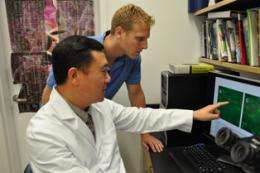Study shows ultrasound triggers bone cell mobility

Research led by Yi-Xian Qin, PhD, Professor, Department of Biomedical Engineering, and Director of the Orthopaedic Bioengineering Research Laboratory at Stony Brook University, demonstrated that the use of medium-intensity focused ultrasound on osteoblasts, known as bone-forming cells, stimulates the mobility of the cells and triggers calcium release, a process that promotes growth.
The technique could provide a foundation for a method to develop non-pharmacologic treatments of osteoporosis, fractures, and other conditions involving bone loss. The team’s research findings are detailed online in the PLoS One article “Mechanobiological Modulation of Cytoskeleton and Calcium Influx in Osteoblastic Cells by Short-Term Focused Acoustic Radiation Force.”
Musculoskeletal tissues, like bone and muscle, have a robust state of dynamic equilibrium in response to mechanical loading and respond to significant stimuli, such as exercise. Dr. Qin and Stony Brook colleagues Drs. Shu Zhang and Jiqi Cheng are investigating how osteoblasts (a bone-forming cell) respond to mechanical signals, such as ultrasound. In laboratory models of murine cells, the research team created a unique method to apply an ultrasound form called acoustic radiation force (ARF) for only one minute on a single osteoblastic cell and groups of cells. They consistently found that ARF through focused ultrasound beam induced cellular cytoskeletal rearrangement, the motility and mobility of the cells, and accelerated intracellular calcium transportations and concentrations.
Dr. Qin’s previous findings with ultrasound include the creation of an ultrasound bone scanning device that is more advanced than existing ultrasound technology and assesses bone parameters beyond mineral density. The device is being developed as a diagnostic tool to predict early bone loss. Dr. Qin and his research team is investigating ways to combine this potential diagnostic tool with the ARF technology in the laboratory to identify bone loss and fracture within a bone region, then provide treatment via ARF to promote growth and healing.















